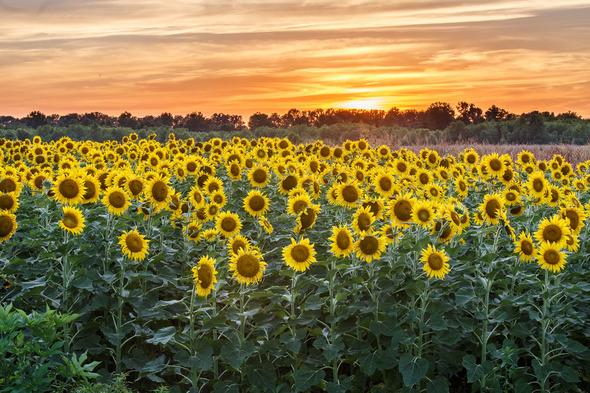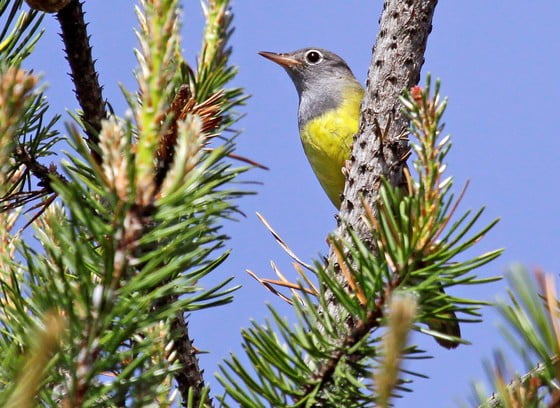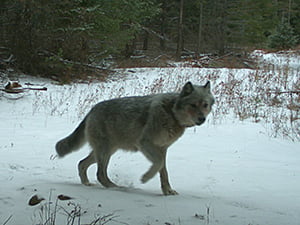Missouri Is Expanding Sunflower Plantings At
Columbia Bottom This Summer

SPANISH LAKE, Mo.—It may seem a little sunnier than usual at Columbia Bottom Conservation Area, even on a cloudy day. Visitors to the area will find some extra splashes of yellow this summer, and for a longer time than usual. That’s because Missouri Department of Conservation (MDC) Wildlife staff at the area are trying out a new sunflower planting strategy this year.
The common sunflower (Helianthus annuus) is an extremely large and showy member from the same plant family as daisies. The impressive height and brilliant yellow rays of a single sunflower are an impressive sight. Uniform rows of hundreds can be positively memorizing.
Spectacular sunflower fields have been a yearly tradition at Columbia Bottom Conservation Area in Spanish Lake. The area is known as an excellent mourning dove hunting destination each September. MDC staff cultivate the sunflower plots as part of their dove management strategy. The large flowers supply seeds that entice the doves, and their lofty stalks create cover for the hunters who pursue them.
“It normally takes about 60 days from planting to flowering,” according to MDC Wildlife Biologist Andy Tappmeyer, who manages Columbia Bottom. His team typically plants about 14 fields throughout the 4,300-acre area in early May as part of the dove management regimen. The large plantings reach fruition by the start of July, and for their 10-day blooming period they decorate the area with vibrant brush strokes of gold. The sight has always been a popular draw for sight-seers, nature buffs, photographers, even couples seeking a picturesque wedding venue.
“This year, we’re giving visitors more chances to enjoy the sunflowers by planting some additional plots,” said Tappmeyer. He said many of the new plantings are close to the visitor center and easily spotted from the road. His staff has staggered the timing of the plantings to spread their blooming periods out over a longer period.
“Visitors should be able to see sunflowers in bloom somewhere on the area through the middle of August or so this year,” Tappmeyer said.
That means that those fascinated with sunflowers should have even more opportunities to view and photograph them.

And there’s a lot to be fascinated with when it comes to the common sunflower. Inside the eye-catching rays on top of each stalk are large, dark brown disks where the action really takes place. These disks hold hundreds of small flowers. Every one of these tiny, disk-shaped blossoms is made up of its own petals, and contains both male and female reproductive parts—the stamen and stigma, respectively. It’s here the magic of pollination occurs, allowing the plant to produce a bounty of seeds. In addition to helping perpetuate the sunflowers, these seeds provide excellent nutrition for birds and wildlife, like doves. Even humans find them a tasty treat.
Those golden outer rays are separate flowers, rather than petals as many assume. This portion of the plant is not reproductive, however. As the early buds develop atop the stalks, they turn to follow the sun’s path through the sky during the day. Once the flowers open, the plants lock their orientation toward the east, and the fields resemble a battalion of yellow soldiers standing at attention.
Common sunflowers are the most important crop plant native to the United States. They’re cultivated worldwide for sunflower oil, which is made from the seeds. At one time, Missouri was a leading producer of the species.
Tappmeyer said the area is open every day from a half hour before sunrise until a half hour past sunset. He also reminded visitors to bring their cameras.
Keep a lookout on Facebook and Instagram—there may just be an explosion of Columbia Bottom “sunflower selfies” this summer.
Columbia Bottom Conservation Area is managed to create a mosaic of bottomland habitats that includes shallow wetlands, bottomland hardwoods, prairie, and cropland.
It is located at 801 Strodtman Road in north St. Louis County.
The area can be reached by taking the Riverview Drive Exit from I-270 and travelling north approximately three miles.

